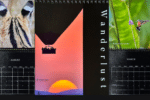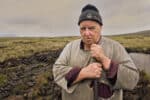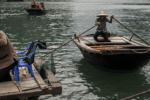As I usually mention when teaching flash lighting, the most important light to observe and work with is not represented by that carton of flashes in the trunk of your car. It’s the ambient light level you encounter on location. Even if you go into a coal mine, and there is no light, that lack of ambient illumination becomes the driver for your flash solution. Likewise, outside, on a sunny day, that nuclear blast of photons up in the sky pushes you to light…or not. So, ironically, when you go on location as a “flash photographer.” no matter how many watt seconds you are packing. the ambient light is the key light to observe and react to.
I was recently in San Diego, and my bud Earnie Grafton set up an impromptu lighting workshop with his former staff mates at the San Diego Union Trib. I enjoy the company of photogs, and working things out together, so when he broached doing this with me, I recall saying yes, and simply asking if he was buying the beers at the end of the day. Earnie being Earnie, a deal was sealed.
We wandered into Chicano Park, and immediately encountered the famous murals there, as well as a very patient, charismatic gentleman who briefly volunteered as our subject.
So, what’s the main light? The sky, to be sure. If I want blue in that sky, I have to underexpose the whole deal, which means bye-bye to my subject, and, very importantly, the signature aspect of the location, the murals. They are in shade, under the highway. Now, as with any photo excursion, there’s about a million different ways to go about getting a photo here. (Okay, that’s an exaggeration–let’s just say there’s a variety.) You could shoot it available light, as we did when we were testing with various members of the Trib staff. Looks fine. In fact, it has a look. Highlight-y, blown out, and a bit airy. All good.
But, if you want the sky, and some drama, and the murals, you have to bring something to the party. For the gentleman at the top, we started, as always, with a main light, an Ezybox 24″ Hot Shoe soft box, which is a staple for me on location. Out of the camera, you get this.
No camera chip can get its head around the value of the sky, and the shadows under the highway. It’s one, or the other. The only way to get the sky, and the paintings, is to effectively resupply the light you have robbed from the murals. We did this with two speed lights, one per side, firing TTL, triggering line of sight from the master. They are each a good 50-60′ away, through bright sun and into shadows. We ran them full blast. The final equation was 1/250 @ f11, ISO 200 on a D4S. The below frame is out of the camera. The same pic is at the top of the blog, one that Cali goosed a bit in PhotoShop, by adding some contrast and opening up some shadows. Then I took it and went old style NPPA on it, burning down the corners a bit. Old habits die hard. Shoulda come down a tad more on my angle to get rid of the highway light, but it ended up there, so I left it alone. Sigh.
Ingredients for the above: Ezy Box Hot Shoe Soft Box; 3 SB 910 flashes; one Avenger C-stand; 2 Manfrotto stacker stands; one Tri-grip reflector.
The crew at the Trib is a good bunch, not only in terms of personality, but also in terms of excellence as shooters. Earnie, sadly, is no longer there. He was laid off earlier this year. It’s the paper’s loss, not to mention the reader’s. Some of his work below.
Too often now, the excellence of photo technology preempts the understanding that there is knowledge and experience needed to put that formidable technology to good use. The game of making pictures is not an exercise in automation and pixels, but a decidedly human endeavor, rife with calculations and enterprise even the priciest camera cannot enact. Sending reporters with Iphones out into the world as a means of cutting through the expensive underbrush of publishing is not an answer.
A dear friend has recently switched venues as an editor, from a very visual publication to a emphatically non-visual one. He’s inundated now with writers who come back from the field absolutely imbued with the sense that their smart phone snap really “gets” the story and is the perfect visual complement to their peerless words. He sighs patiently, and assigns a photog. (I’ve been blessed with working with many writers who know the most stirring combination in all of storytelling is an effective combination of words and pictures. But then, there are those writers you grapple with occasionally. A TIME writer I was working with on a cover story once announced at the dinner table that “Joe’s pictures are the whores that sell the chalice of my words.” He was being utterly serious.)
The “10,000 hours” rule applies dramatically to photography, despite the allure of instantaneous success presented by the high technology. Earnie, a former military shooter and a fourteen year newspaper veteran, has logged that irreplaceable time as have his mates still at the paper. Just because there are motor driven cameras out there in the world churning out easily procurable, well exposed, sharp images doesn’t mean those images are pertinent, or even any good. Ya gotta have an eye and a heart behind the lens, and if that head and heart are possessed of wisdom and know how, that is to the betterment of everyone–the editors, the readers, and the all important advertisers.
That deep well of human experience a shooter like Earnie (and many other photogs who have been dismissed in the budgetary free fall of publications) carry around in their camera bag is no longer available to the readers of the Trib, and surely it will be noticed over time. This development also means, at least temporarily, that Grafton might end up with too much time on his hands, and that’s truly disconcerting.
It was a good day in Chicano Park, in the company of photographers.
More tk….




















Amen to last part.
Greetings Joe,
Did you and the gang wander over to “Las Cuatro Milpas” for some mexican food? Anytime, I’m in the Barrio Logan area, I make it a point to stop and eat there.
Joe:
Your photos are of much greater value to all of us, and are treasures. Unfortunately the flood of images means that there has to be better editors who sift through the noise to find the keepers. We are changing the delivery of news and images, and this has had a huge toll on the journalism field. There will always be a need for content, and great images and great content will rise to the top. How that gets done in the internet world of streaming images is still to be seen, but we all keep trying. Your blog is a perfect example of that world. No longer tethered to a single magazine or employer, you deliver the information and pictures directly to users who want to see your content.
It is a brave new world.
All the best to Earnie and you.
Bill Bogle, Jr.
My professor in college, told me when I graduated to take 10,000 photos and decide if this is where I wanted to be. That was 1985. It was some of the greatest advice I received. I admire Joe’s work because of the time he has spent behind the camera giving us his heart. My photojournalistic friends have done the same and the hours spent honing their craft have enriched, enticed, and encouraged us to look at the world differently. The digital revolution has changed photography for the better in many ways, but one of the biggest losses is the talent of photographers who were out there on a daily basis with a “slow news day” bringing us photos that made us want to be there. Their inspiration will be missed.
as a pro shooter for 45 years, from sheet film days (crown graphic, some people don’t know what that is) it’s amazing the changes that have been made, but one thing has always remained the same, quality and heart. I am sure you have seen excellent work done on point and shoot and box cameras. some of these new people today can’t see that its not the equipment, but the heart, soul, and good eye for what/s taking place to produce good work. I love your work, taking advantage of all the new tech products out there but it all goes back to good manual basics of camera and light and working with what you have and using your eye and everyday knowledge, like your friend has from doing it from the seat of your pants, sometimes right, sometimes wrong, but the end of the day getting it right. We just keep on keeping on. 72 and still doing portraits and commercial and loving every day.
this replacing quality with quanity is prevalent in way too many venues today, not only photography. think is will always catch up to you in the end and bite you in the butt in some way.
“A TIME writer I was working with on a cover story once announced at the dinner table that ‘Joe’s pictures are the whores that sell the chalice of my words.’ He was being utterly serious.”
Too bad. That would have been a great humorous line spoken by a friend. Instead it revealed the speaker to be a mid-level talent at best envious of Joe’s artistry.
Eloquent. Truthfully, especially the line about needing a heart behind the camera- there is truth in the cliche that a “Picture is worth a thousand words” it’s a shame the words have become commodities… as have the images- you are an inspiration to use folks trying to figure all of this stuff out, and I have always admired your “heart” Joe- it’s always perfectly exposed.
Warhols “15 minutes of fame” has been reduced to 15 seconds when a your photo of a sunrise/sunset is shown on local news.
Joe, we have a tenuous link. I was in Cub Scouts and went to high school with Sam Abel.
I think this is one of your most pointed blog posts to date. It’s always good and helpful for you to share your trade tips with us; but, I really appreciated this article for your keen insights in the spiritual aspect of the craft and the unfortunate state of the industry remarks.
I hope this period is a phase. I also hope photographers will work through it and continue to push new boundries.
Unfortunately the ‘smarter’ and more accessible technology becomes, the more society in general seems to lose respect and appreciation for genuine skill, knowledge and experience. I can’t remember where I read or heard the statement “The smarter cameras get the dumber some photographers seem to become” but it rings true with a lot that I have observed in recent times. Unfortunately the dumbness isn’t isolated to certain self proclaimed pros, it also spreads itself around and infects many others involved in the picture taking/commissioning/purchasing/editing process.
Thank god there are people like yourself Joe who continue to provide a window into the realities and worth of genuine professional work.
I’m a physician, specialized in Radiology, subspecialized in ultrasound. I also happen to be a photographer who tries to get better, … slowly. Medicine in this case is very similar to photography. I will take someone who knows what they are doing with a 20 year old piece of ultrasound equipment any day of the week over someone using the latest and greatest after a two month course.
There was a great psych study some years ago about telling a joke. It’s the old adage of a “little bit of knowledge is dangerous”. It turns out that you must know a fair amount about joke telling to even realize how bad you are.